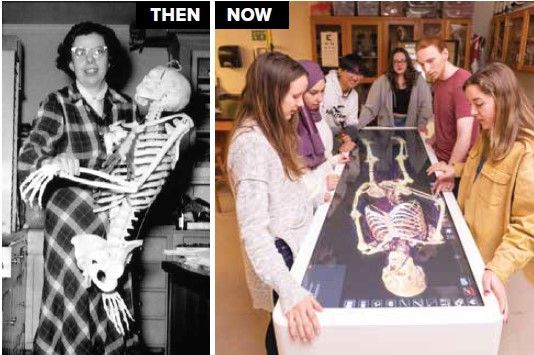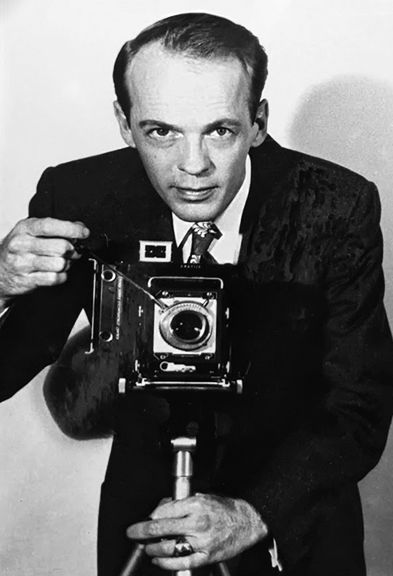Science has been a priority for Penn State Behrend from its start. When Behrend Center opened in 1948, the single academic building, formerly the barn on the Glenhill estate, included two laboratories—one for physics and one for biology—and the Behrend family’s former carriage house was turned into a chemistry lab. In the early days of the campus, nearly half of the available learning space was dedicated to the sciences.
By 1963, the student body had more than doubled to 300-plus students, and the science curricula took a giant leap forward with construction of the Otto F. Behrend Science Building. The facility was made possible by a gift from the estate of Ernst Behrend’s brother; at the time, it was the largest gift Penn State had ever received from a private individual.
In 1967, the Division of Science, as it was then known, hired its first female faculty member. Dr. Libby Smith, who taught biology. A colorful character beloved by students, Dr. Smith had a pet rat named Frisky and once canceled class so she could go to the airport to pick up a “very important jellyfish.”
When the Penn State Board of Trustees authorized Behrend as the first campus outside of University Park to grant four-year degrees, the campus became The Behrend College. In the spring of the following year, Behrend awarded its first four-year science degrees—one in Chemistry, two in Biology, one in Mathematics, and one in Secondary Mathematics Education.
Mathematics faculty members Dr. Ron Larson and Dr. Robert Hostetler would publish their first calculus textbook in 1979, and Larson would go on to establish a mathematics textbook company with four employees in the South Cottage on campus. The company grew steadily, and today, nearly 100 employees of Larson Texts and its publishing arm, Big Ideas Learning, produce mathematics education materials for kindergarten through college calculus.
In 1997, the Division of Science became the School of Science, one of four academic schools of today’s college. A few years later, largely due to the work of Dr. Edward Masteller, professor emeritus of biology, Penn State Behrend earned recognition as an arboretum. It has since earned the Tree Campus USA designation from the Arbor Day Foundation.
In 2006, given growth in science enrollment, programs, and course offerings, the school easily settled into the full set of buildings formerly occupied by the School of Engineering—what recent graduates and today’s students know as the Science Complex. The school’s chemistry labs, located in Otto Behrend Science Building, subsequently underwent a $4.2 million overhaul in 2010, creating state-of-the-art facilities.
When the Erie Historical Society decided to close the Erie Planetarium in downtown Erie in 2014, the dome was moved to the School of Science, and Yahn Planetarium, supported by gifts from Erie’s Yahn family, was born. The planetarium offers weekly public shows in addition to a variety of programming for college students and outside groups, including K-12 schools.
In 2020, Penn State Behrend announced a $26 million initiative with Magee-Womens Research Institute to bring locally focused clinical medical research trials to the region, improving the health of generations of women. The initiative has led to the creation of two new facilities—the Christine E. Shewfelt Advanced Biochemistry and Molecular Biology Teaching Lab and the Janis L. Hill Biomedical and Translational Research Lab, where School of Science faculty are actively engaged in biochemistry and molecular biology research.
From 1948 to 2023, the history of Penn State Behrend has been as much about the evolution of science education as any other advancement. The highlights in this story only begin to scratch the surface of the role the sciences have played in the growth and success of Penn State Behrend over 75 years.
Patterson’s Photo Legacy
Though he taught generations of college students during his thirtyseven- year tenure as a mathematics professor at Behrend, Norman B. “Bill” Patterson established a legacy that goes far beyond linear algebra, differential equations, and statistics. When he retired in 1990, he left a treasure trove of photos documenting life at Behrend with intimacy and affection.
The camera he used to record much of it—a $129 model he saved all year to buy from Erie’s Boston Store in 1954—is in the archives at Lilley Library along with hundreds of his photos, a true gift to the college. The black-and-white photos shown here were taken by Patterson.
As was customary in higher education, faculty members in the early days of Behrend were heavily involved in the life of the campus and its students. There were few administrators and staff members. It was faculty members who helped with student clubs, activities, and events.
“I was up there at the college for events and things three, four nights a week,” Patterson said. “And if you saw me, my camera would be right next to me. I took it with me everywhere I went.”
Read the full story about Patterson at Behrendblog.com.

